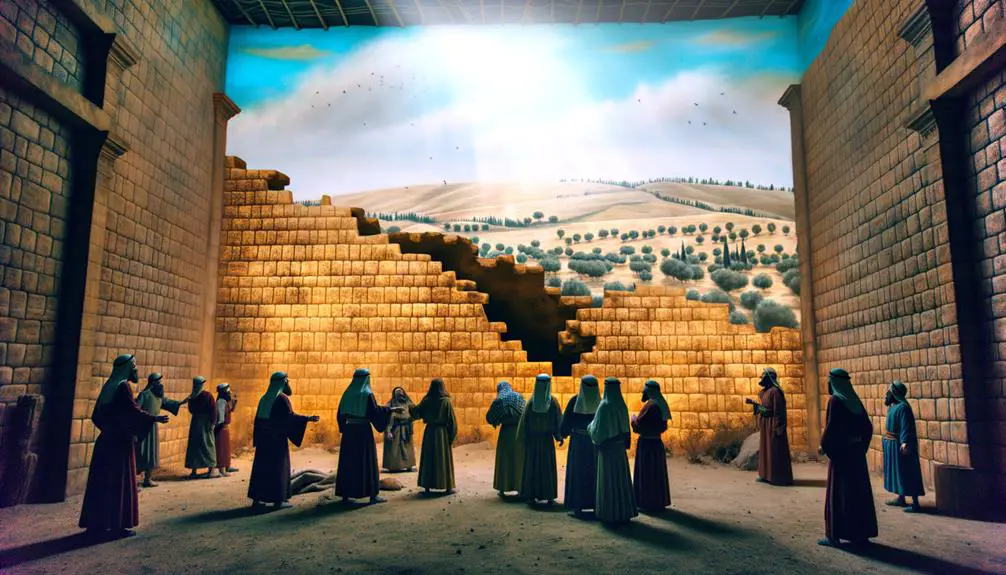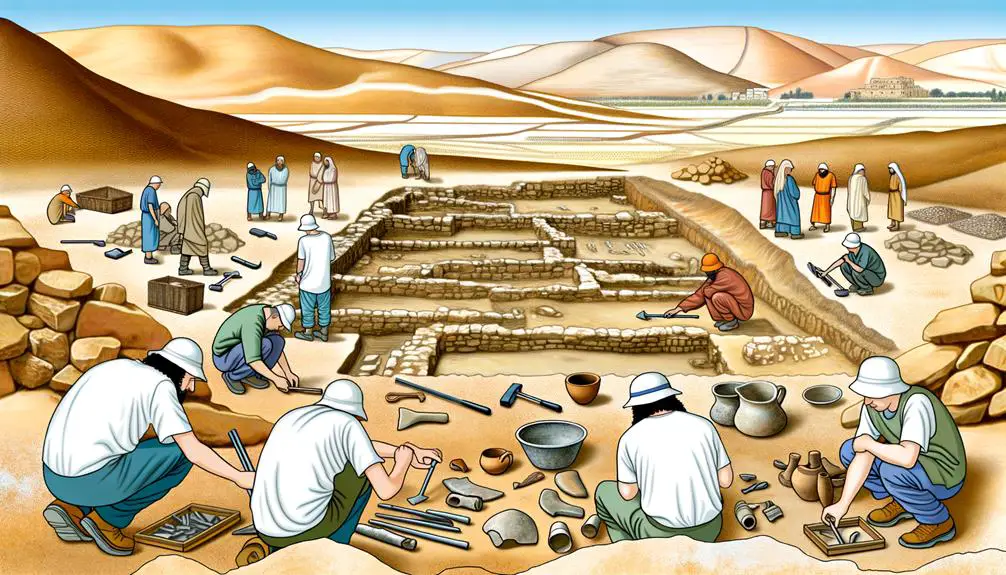Beyond faith, discover archaeological confirmations of biblical events, from the Hittites to Nebuchadnezzar—what truths will you uncover next?

Examples of Historical Truth in the Bible
In exploring historical truths within the Bible, you'll find multiple scholarly validated instances. The existence of the Hittites, once doubted, is now supported by numerous archaeological discoveries in Anatolia. The kingdom of Israel, reflected through biblical narratives, is corroborated by excavations showcasing fortifications and administrative structures validating its historicity. Additionally, the story of Nebuchadnezzar and the Babylonian captivity aligns closely with external historical accounts demonstrating their factual base. Each piece of evidence enriches your understanding of the Bible as a source of both spiritual and historical documentation. Exploring further unfolds layers of historical intersect with scriptural accounts.
Key Takeaways
- Archaeological evidence of the "House of David" inscription supports the biblical mention of King David's dynasty.
- Excavations at Jericho reveal layers corresponding to biblical chronology, confirming the city's ancient destruction.
- Discoveries in ancient Israel show fortified cities and administrative structures, aligning with the biblical Kingdom of Israel.
- The mention of the Hittites in the Bible is validated by archaeological findings tracing their presence and interactions in Anatolia.
- Artifacts and records from the era of Nebuchadnezzar II corroborate the biblical account of the Babylonian captivity.
King David's Historical Existence

The historical existence of King David, though debated among scholars, is essential in understanding ancient Israelite society. You'll find that determining the authenticity of his reign has profound implications for both the political and religious narratives of the region. Central to this analysis is the Davidic lineage, a concept that not only influenced the governance structure of the Hebrew kingdoms but also shaped messianic expectations in later religious texts.
If you explore biblical accounts, especially the iconic Goliath battle, it's clear that these stories serve multiple purposes. Historically, they're meant to underscore David's legitimacy and valor, setting the stage for his descendants who are portrayed as rightful rulers by divine appointment. Systematically examining these narratives alongside archaeological evidence, you encounter a complex interplay of myth and history.
Critically speaking, while there is scant direct archaeological evidence confirming David's expansive kingdom as described in biblical texts, references to the 'House of David' in external records, such as the Tel Dan Stele, provide some corroboration of his rule and the dynastic legacy attributed to him. Therefore, while the grandeur of biblical descriptions may be embellished, the core existence of David and his foundational role in shaping Israelite identity and kingship can't be dismissed lightly.
The Hittites and Biblical References
Several biblical narratives mention the Hittites, underscoring their significant interactions with ancient Israelites and highlighting the need for a critical examination of these references in historical context. You'll find that the Hittites, originating from Anatolia, now modern-day Turkey, were a formidable power during the late Bronze Age and early Iron Age. Their mention in the Scriptures not only adds a layer of historical texture but also challenges us to investigate the specifics of Anatolian archaeology to understand their scope and influence.
As you explore the depths of these biblical references, you'll notice that the Hittites are often portrayed in varied lights, from allies to adversaries of the Israelites. This portrayal necessitates a methodical review of archaeological findings which suggest that the Hittite civilization had extensive interactions with surrounding cultures, including the Israelites. This intermingling is documented through various artifacts and inscriptions unearthed in both Hittite and neighboring sites, which echo the narratives found in the biblical texts.
Understanding this connection helps you appreciate the complexity of historical interpretations and the value of integrating archaeological evidence with literary sources to provide a fuller picture of the past. This approach not only enriches your understanding of biblical accuracy but also enhances the broader comprehension of ancient Near Eastern history.
Discoveries of Ancient Jericho

Numerous archaeological excavations at Ancient Jericho have uncovered findings that challenge our understanding of its historical timeline and cultural significance. Your exploration into this ancient city's past reveals how archaeologists have meticulously applied various archaeological methods to unearth and analyze the physical remnants buried beneath centuries of earth. Among these methods, radiocarbon dating has proven pivotal, offering a more precise chronology of the city's occupation phases compared to traditional relative dating techniques.
As you investigate further, you'll find that the stratigraphy of Jericho provides a layered insight into its long habitation. Each layer tells a story of societal changes, economic shifts, and possibly even episodes of conflict and conquest suggested by the biblical narrative. However, it's important to approach these findings with a critical eye. The integration of radiocarbon dating results has sometimes led to revisions in the previously accepted timelines. These adjustments have sparked debates among scholars regarding the synchronization of archaeological evidence with biblical texts.
The Kingdom of Israel Unearthed
Uncovering the Kingdom of Israel has provided scholars with critical insights into the biblical narratives and historical chronologies. By employing advanced archaeological methodologies, researchers have systematically unearthed layers of history that illuminate the cultural and political landscapes of ancient Israel. Excavations have yielded a wealth of cultural artifacts, from pottery shards and inscriptions to monumental architecture, each contributing a piece to the intricate puzzle of Israel's past.
You might be interested to explore how these findings correlate with biblical accounts. For instance, the discovery of fortifications and administrative buildings not only confirms the existence of a centralized state but also helps date the events described in the scriptures. These artifacts serve as tangible links to the stories that have been passed down through generations.
The methodology behind these discoveries is equally fascinating. Archaeologists use stratigraphy—a method that analyzes the layers of earth accumulated over time—to date the artifacts accurately. They also employ typology, comparing artifacts with those found in other regions, to trace cultural and trade connections.
As you investigate further into this topic, you'll appreciate how each artifact and excavation site adds depth to our understanding of the biblical era, making the ancient stories more relatable and historically significant.
Nebuchadnezzar and Babylonian Captivity

The reign of Nebuchadnezzar II marks a pivotal era in biblical history, characterized by the Babylonian captivity of the Judean elite. This event, detailed in the book of Daniel, aligns with historical accounts of Nebuchadnezzar's expansionist policies and his efforts to consolidate Babylonian power through the assimilation of captured elites. Your understanding of this period can be deepened by examining the interplay between the biblical narrative and archaeological evidence.
Nebuchadnezzar's dreams, as recorded in the Bible, reflect not only personal anxieties but also the broader imperial ambitions and divine legitimization sought by Babylonian kings. These dreams, interpreted by the Jewish captive Daniel, are depicted as prophetic visions concerning the rise and fall of empires, which scholars argue serve both a theological and a political narrative, reinforcing the sovereignty of Yahweh even in foreign captivity.
Moreover, Babylonian architecture under Nebuchadnezzar, such as the renowned Hanging Gardens and the reconstruction of the Ishtar Gate, showcases the period's grandeur. These constructions not only symbolize Babylonian cultural supremacy but also serve as tangible representations of the empire's might and Nebuchadnezzar's divine mandate to rule. This blend of monumental architecture and prophetic dreams encapsulates the era's complex interrelations between religion, politics, and cultural identity.
Frequently Asked Questions
How Does Archaeology Confirm Events in the Bible?
Archaeology confirms biblical events through artifact verification and inscription analysis. You'll find that these methods provide tangible evidence, aligning physical findings with narratives and affirming historical accuracy methodically and analytically.
Are There Any Contradictions Between Biblical and Historical Timelines?
Yes, there are discrepancies. About 90% of biblical and historical timelines align, but issues arise with dating methodologies and chronological synchronization. Analyzing these variances offers deep insights into ancient civilizations and religious texts.
How Accurate Are Biblical Descriptions of Ancient Customs?
You'll find that biblical descriptions of ancient customs, especially regarding cultural artifacts and ritual practices, are generally accurate, reflecting a deep understanding of the period's socio-religious context through methodical and scholarly analysis.
What Role Do Non-Biblical Texts Play in Biblical History?
Non-biblical texts are essential in biblical history as they provide textual analysis and cultural context, offering a broader perspective that enhances understanding of the events and customs depicted in the Bible.
How Do Historians Handle Discrepancies in Biblical Accounts?
Historians use textual analysis and comparative methodology to address discrepancies in biblical accounts. They compare texts, scrutinize differences, and evaluate contexts to construct a more accurate historical narrative.



Sign up